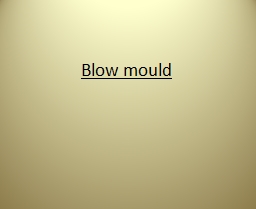

There are three main processes used by the blow moulding industry Injection blow moulding Extrusion blow moulding and Stretch blow moulding 2 Injection blow moulding Used for small bottles of less than 500 ml volume ID: 1020266
Download Presentation The PPT/PDF document "Blow mould Introduction: Blow Moulding" is the property of its rightful owner. Permission is granted to download and print the materials on this web site for personal, non-commercial use only, and to display it on your personal computer provided you do not modify the materials and that you retain all copyright notices contained in the materials. By downloading content from our website, you accept the terms of this agreement.
1. Blow mould
2. Introduction: Blow MouldingThere are three main processes used by the blow moulding industry : Injection blow moulding, Extrusion blow moulding, and Stretch blow moulding.2
3. Injection blow mouldingUsed for small bottles of less than 500 ml volume. The process is scrap-free, with accurate control of neck finish. It is particularly useful for oval bottles. However, this is not suitable for containers with handles. 3
4. Extrusion blow mouldingUsed for bottles of 250 ml in volume or larger. Tanks as large as 1000 liter weight can be moulded. Mould is less expensive. Containers with handles are easily fabricated. 4
5. Stretch blow mouldingUsed for bottles of 250-2000 ml in size, and some times as large as 25 liter. The molecular bi-axial orientation of certain resins enhances stiffness, and barrier properties.5
6. Injection Blow Mould6
7. Injection Blow MouldInjection blow moulding requires two moulds: preform mouldblow mould. 7
8. The blow mould consists of the bottle cavity, neck-ring insert, and bottom-plug insert.8
9. Injection mould & blow mould:9
10. Preform cavity The preform mould consists of the preform cavity, injection nozzle, neck-ring insert, and core-rod assembly. 10
11. The preform cavity design is based on the following parameters:length-to-diameter ratio (10:1 or less), ratio of preform size to maximum bottle size (3:1 or less), the parison wall thickness (2-5 mm),neck-ring.11
12. Mould of a preform:12
13. Neck designA neck-ring insert forms the finish or threaded neck section of the bottle. The core-rod assembly forms the interior of the preform and supports the parison or the bottle during transfer. 13
14. During the blowing process, the neck-finish area of the parison must be cooled to retain its shape; the remainder of the parison is kept hot for expansion in the bottle cavity.14
15. The neck-ring insert is used in the bottle cavity in a manner similar to its use in the parison cavity. The thread diameter dimensions in the bottle cavity are 0.05–0.25 mm larger than in the preform cavity.15
16. Core rod:16
17. Mould CoolingNormally, a blow-moulded part is cooled externally in the mould.Some internal cooling systems have been designed to speed up the product cooling process. 17
18. There are three basic systems of mould cooling: liquefied gasSuper-cold air with water vaporair- exchange method18
19. 1. liquefied-gas systemNon-inflammable liquefied gas (such as CO2, or N2) is atomized through the blow pin into the bottle immediately after the parison expansion. This method has increased production rates by 25–35%. 19
20. 2. Super cold air systemA stream of very dry air expands the parison and circulates through the bottle. Immediately after the parison expansion, a fine mist of water is injected into the cold air stream and turns into snow. 20
21. As the snow circulates through the container, it melts and vaporizes. At the end, the water mist is stopped first. The circulating air dries the interior before the mould is opened.Production rates can be improved as much as 50%.21
22. 3. Air-exchange systemIn the air-exchange system the plant air is circulated through the bottle and is exhausted after the parison expansion.Production rate increases by only 10–15%.22
23. Ejection systemEjection of the blow moulded part is carried out by a stripper which separates the formed containers from the core rods. The stripper consists of a stripper base, a stripper plate, screws, and washers. 23
24. On most machines the stripper is able to rotate 90◦ downward to deposit the product onto a conveyor. Once the bottle is dropped on a conveyor belt, the stripper returns for the next cycle. 24
25. EXTRUSION Blow Mould25
26. Extrusion blow mouldThe extruded hot parison is captured between two mould halves. For blowing the parison, air enters through a blow pin and expands the visco-elastic stage plastic into the mould. 26
27. Parison formation:27
28. Pinch‐off Pinch‐off is a raised edge around the cavity in the mold that seals off the part and separates the excess material.Pinch‐off land is the width of the pinch‐off blade that seals the parison.28
29. 29
30. Cavity ventingAll blow moulds are properly vented. The air that first occupies the product area escapes rapidly when parison blows. 30
31. In case of poor venting, the entrapped air in the mould prevents good contact between the parison and the mould cavity surface and the surface of blown part becomes rough.Moulds are easily vented by means of their parting line through small holes. 31
32. Effect of vent size on the product wall:32
33. Parison thickness controlParison programming is required to control the wall thickness of the parison. 33
34. There are two methods to control the parison wall thickness. By varying the orifice size in the extrusion dieBy varying the rate of extrusion.34
35. 1. Variable orifice methodVariable orifice method is suitable for the continuous extrusion blow moulding. In this method the programming system varies the opening of the orifice. The orifice opening can be changed either by moving the mandrel or the bushing.35
36. Die head of the variable orifice :36
37. 2. Variable rate of extrusion methodThe variable rate of extrusion method is suitable for intermittent extrusion blow moulding. This is suitable for a ram accumulator blow moulding machine.37
38. Extrusion blow moulding38
39. Parison formation39
40. Parison “swell” and “sag”40
41. Stretch blow mould41
42. Comparison of blow moulding techniques42